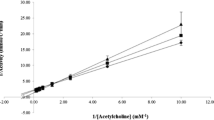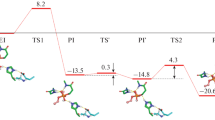Abstract
Reactivation of electric eel acetylcholinesterase (AChE) inhibited by MeO(NH2)P(O)SMe (methamidophos) and by MeS(NH2)P(O)SMe was studied at pH 7.5 and 25° C. The former inhibited enzyme shows a rather rapid spontaneous reactivation (t1/2=3.7 h); this reactivation is accelerated by 1 μM of the bispyridinium oximes TMB4 and obidoxime, and, to a lesser extent, by the monopyridinium oximes P2S and its 1-benzyl analogue (benzyl-P2A). The latter inhibited enzyme shows rapid aging (t1/2=0.6 h). Reactivation with 1 mM of the bispyridinium oximes is incomplete and reactivation with 1 mM of the monopyridinium oximes proceeds very slowly. These large differences between the properties of the two inhibited enzymes indicate that the methylthio group is the leaving group during inhibition of AChE by methamidophos. Additional support is afforded by the observation of induced aging of the former inhibited enzyme by thiourea.
Upon comparison of the reactivation of AChE inhibited by methamidophos with that of AChE inhibited by an N-methyl analogue, cruf ornate, and an N,N-dimethyl analogue, tabun, it appears that the rate of spontaneous reactivation decreases with increasing alkylation of the P-NH2 group. Whereas benzyl-P2A is somewhat less active than P2S for reactivation of AChE inhibited by methamidophos, it is superior to P2S for reactivation of AChE inhibited by crufomate and also superior to P2S and to the bispyridinium oximes for AChE inhibited by tabun.
Similar content being viewed by others
References
Clothier B, Johnson MK, Reiner E (1980) Interaction of bovine erythrocyte acetylcholinesterase with trialkyl phosphorothiolates. Abstracts of the 2nd international congress on toxicology. Toxicol Lett, special issue, p 138
Fahmy MAH, Khasawinah A, Fukuto TR (1972) Alkaline hydrolysis of phosphoramidothioate esters. J Org Chem 37:617–625
Heilbronn E (1963) In vitro reactivation and “aging” of tabun-inhibited blood cholinesterasees. Biochem Pharmacol 12: 25–36
Heilbronn E, Tolagen B (1965) Toxogonin in sarin, soman and tabun poisoning. Biochem Pharmacol 14: 73–77
De Jong LPA, Wolring GZ (1978) Effect of 1-(ar)alkyl-2-hydroxyiminomethyl-pyridinium salts on reactivation and aging of acetylcholinesterase inhibited by ethyl dimethylphosphoramidocyanidate (tabun). Biochem Pharmacol 27: 2229–2235
De Jong LPA, Wolring GZ (1980) Reactivation of acetylcholinesterase inhibited by 1,2,2′-trimethylpropyl methylphosphonofluoridate (soman) with HI-6 and related oximes. Biochem Pharmacol 29: 2379–2387
De Jong LPA, Benschop HP, van den Berg GR, Wolring GZ, de Korte DC (1981) Reactivation of tabun-inhibited acetylcholinesterase by 1-(hetero)arylmethyl-pyridinium-oximes. Eur J Med Chem Chim Ther 16:257–262
Keijer JH (1970) Automated potentiometric procedure of esterase assay. Anal Biochem 37:439–446
Mel'nikov NN, Tuturina NN, Khaskin BA (1966) Organic insectofungicides XCVII. Reactions of phosphorodithioic esters with tertiary aliphatic phosphines. Zh Obshch Khim 36:1082–1086
Pearson RG (1963) Hard and soft acids and bases. J Am Chem Soc 85:3533–3539
Quistad GB, Fukuto TR, Metcalf RL (1970) Insecticidal, anticholinesterase, and hydrolytic properties of phosphoramidothiolates. J Agric Food Chem 18:189–194
Regel EK, Botts MF (1970) S-Carbethoxymethyl-S,S-dialkyltrithiophosphates as soil fungicides. U.S. patent 3,502,771. Chem Abstr 73: 24903
Robinson CP, Beiergrohslein D (1980) Cholinesterase inhibition by methamidophos and its subsequent reactivation. Pestic Biochem Physiol 13:267–273
Rozengart VI, Balashova EK (1965) Mechanism of “aging” of cholinesterase inhibited by organophosphorus inhibitors. Dokl Akad Nauk SSSR 164:937–940
Saville B (1967) The concept of hard and soft acids and bases as applied to multi-center reactions. Angew Chem 6: 928–939
Scaife JF (1959) Oxime reactivation studies of inhibited true and pseudo cholinesterase. Can J Biochem Physiol 37: 1301–1311
Schoene K, Oldiges H (1973) Die Wirkungen von Pyridiniumsalzen gegenüber Tabun-and Sarinvergiftungen in vivo und in vitro. Arch Int Pharmacodyn Ther 204: 110–123
Author information
Authors and Affiliations
Rights and permissions
About this article
Cite this article
de Jong, L.P.A., Wolring, G.Z. & Benschop, H.P. Reactivation of acetylcholinesterase inhibited by methamidophos and analogous (di)methylphosphoramidates. Arch Toxicol 49, 175–183 (1982). https://doi.org/10.1007/BF00332365
Received:
Issue Date:
DOI: https://doi.org/10.1007/BF00332365




